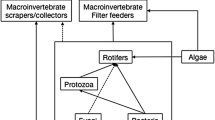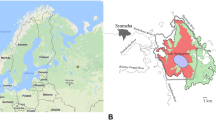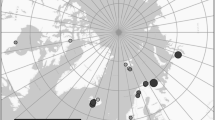Abstract
Both top-down and bottom-up processes are common in terrestrial ecosystems, but how these opposing forces interact and vary over time is poorly understood. We tested the variation of these processes over seasonal time in a natural temperate zone grassland, a field site characterized by strong seasonal changes in abiotic and biotic conditions. Separate factorial experiments manipulating nutrients and cursorial spiders were performed in the wet and dry seasons. We also performed a water-addition experiment during the summer (dry season) to determine the degree of water limitation during this time. In the spring, nutrient addition increased plant growth and carnivore abundance, indicating a bottom-up control process. Among herbivores, sap-feeders were significantly enhanced while grazers significantly declined resulting in no net change in herbivore abundance. In the summer, water limitation was predominant increasing plants and all herbivores while nutrient (N) effects were non-significant. Top-down processes were present only in the spring season and only impacted the guild of grazing herbivores. These results show that bottom-up limitation is present throughout the season in this grassland, although the specific limiting resource changes as the season progresses. Bottom-up processes affected all trophic levels and many different guilds, while top-down effects were limited to a select group of herbivores and did not extend to the plant trophic level. Our results show that the relative strengths of top-down and bottom-up processes can shift over relatively short periods of time in habitats with a strong seasonal component.









Similar content being viewed by others
References
Baldridge CD, Moran MD (2001) Behavioral means of coexisting in old fields by heterospecific arthropod predators (Araneae: Lycosidae, Salticidae; Insecta: Coleoptera, Carabidae). Proc Entomol Soc Wash 103:81–88
Beckerman AP, Uriarte M, Schmitz OJ (1997) Experimental evidence for a behavior-mediated trophic cascade in a terrestrial food chain. Proc Natl Acad Sci USA 94:10735–10738
Bock MT, Bock JH, Grant MC (1992) Effects of bird predation on grasshopper densities in an Arizona grassland. Ecology 73:1706–1717
Chase J (1996) Abiotic controls of trophic cascades in a simple grassland food chain. Oikos 77:495–506
Chase J (1998) Central place forager effects on food chain dynamics and spatial pattern in Northern California meadows. Ecology 79:1236–1245
Denno RF, Douglas LW, Jacobs D (1986) Effects of crowding and host plant nutrition on a wing-dimorphic planthopper. Ecology 67:116–123
Denno RF, Gratton C, Peterson MA, Langellotto GA, Finke DL, Huberty AF (2002) Bottom-up forces mediate natural-enemy impact in a phytophagous insect community. Ecology 83:1443-1458
Döbel HG, Denno RF (1994) Predator planthopper interactions. In: Denno RF, Perfect TJ (eds) Planthoppers: their ecology and management. Chapman and Hall, New York, pp 325–399
Fagan WF, Siemann E, Mitter C, Denno RF, Huberty AF, Woods HA, Elser JJ (2003) Nitrogen in insects: implications for trophic complexity and species diversification. Am Nat (in press)
Floyd T (1996) Top-down impacts on creosote herbivores in a spatially and temporally complex environment. Ecology 77:1544–1555
Forkner RE, Hunter MD (2000) What goes up must come down? Nutrient addition and predation pressure on oak herbivores. Ecology 81:1588–1600
Fraser LH, Grime JP (1998) Top-down control and its effect on the biomass and composition on three grasses at high and low soil fertility in outdoor microcosms. Oecologia 113:239–246
Fretwell S (1977) The regulation of plant communities by the food chains exploiting them. Perspect Biol Med 20:169–185
Hairston NG, Smith FE, Slobodkin LB (1960) Community structure, population control, and competition. Am Nat 44:421–425
Halaj J, Wise DH (2001) Terrestrial trophic cascades: How much do they trickle? Am Nat 157:262–281
Hunter MD, Price PW (1992) Playing chutes and ladders: heterogeneity and the relative roles of bottom-up and top-down forces in natural communities. Ecology 73:724–732
Letourneau DK, Dyer LA (1998) Experimental test in lowland tropical rainforests shows top-down effects through four trophic levels. Ecology 79:1678–1687
Marquis RJ, Whelan CJ (1994) Insectivorous birds increase growth of white oak through consumption of leaf-chewing insects. Ecology 75:2007–2014
Mattson WJ (1980) Herbivory in relation to plant nitrogen content. Annu Rev Ecol Syst 11:119–161
Moran MD, Hurd LE (1998) A trophic cascade in a diverse arthropod community caused by a generalist arthropod predator. Oecologia 113:126–132
Moran MD, Scheidler AR (2002) Effects and nutrients and predators on an old-field food chain: interactions of top-down and bottom-up processes. Oikos 98:116–124
Moran MD, Rooney TP, Hurd LE (1996) Top down cascade from a bitrophic predator in an old field community. Ecology 77:2219–2227
Oksanen L, Oksanen T (2000) The logic and realism of the hypothesis of exploitation ecosystems. Am Nat 155:703–723
Oksanen LS, Fretwell D, Arruda D, Neimela P (1981) Exploitation ecosystems in gradients of primary productivity. Am Nat 118:240–261
Power ME (1992) Top-down and bottom-up forces in food webs: do plants have primacy? Ecology 73:733–746
Ritchie ME (2000) Nitrogen limitation and trophic vs abiotic influences on insect herbivores in a temperate grassland. Ecology 81:1601–1612
Root RB (1973) Organization of a plant-arthropod association in simple and diverse habitats: the fauna of collards (Brassica oleracea). Ecol Monogr 43:95–124
Rosemheim JA, Wilhoit LR, Armer CA (1993) Influence of intraguild predation among generalist predators on the suppression of an herbivore population. Oecologia 96:439–449
Schmitz OJ (1994) Resource edibility and trophic exploitation in an old-field food web. Proc Natl Acad Sci USA 91:5364–5367
Schmitz OJ (1998) Direct and indirect effects of predation and predation risk in old-field interaction webs. Am Nat 151:327–342
Schmitz OJ, Suttle KB (2001) Effects of top predator species on direct and indirect interactions in a food web. Ecology 82:2072–2081
Schmitz OJ, Beckerman AP, O'Brien KM (1997) Behaviorally-mediated trophic cascades: the effects of predation risk on food web interactions. Ecology 78:1388–1399
Schmitz OJ, Hambäck PA, Beckerman AP (2000) Trophic cascades in terrestrial systems: a review of effects of carnivore removals on plants. Am Nat 155:1441–153
Skelton L, Polk A, Fitzgerald BC, Moran MD (2003) Fire effects on three trophic levels. Proc Arkansas Acad Sci (in press)
Snyder WE, Ives AR (2001) Generalist predators disrupt biological control by a specialist parasitoid. Ecology 82:705–716
Stiling P, Rossi AM (1997) Experimental manipulations of top-down and bottom-up factors in an in-trophic system. Ecology 78:1602–1606
Strong DR (1992) Are trophic cascades all wet? Differential and donor-control in speciose ecosystems. Ecology 73:747–754
Uriarte M, Schmitz OJ (1998) Trophic control across a natural productivity gradient. Oikos 82:522–568
Vince SW, Valiela I, Teal JM (1981) An experimental study of the structure of herbivorous insect communities in a salt marsh. Ecology 62:1662–1678
Von Ende CN (2001) Repeated measures analysis: growth and other time dependent measures. In: Scheiner SM, Gurevitch J (eds) Design and analysis of ecological experiments. Oxford University Press, New York, pp 134–157
Acknowledgements
We wish to thank K. Spencer, S. Tracy, E. Jensen, L. Galligan, and N.A. Belle for their help in the field. B. Stevenson and S. Starnes assisted in the arthropod sorting. Special thanks to E. Thomas and K. Albrecht for access to their land. L.E. Hurd and W.E. Snyder provided valuable criticism to an earlier version of the manuscript. O.J. Schmitz and anonymous reviewers greatly improved the final version. This work was supported in part by a grant from the Arkansas Science and Technology Authority.
Author information
Authors and Affiliations
Corresponding author
Rights and permissions
About this article
Cite this article
Boyer, A.G., Swearingen, R.E., Blaha, M.A. et al. Seasonal variation in top-down and bottom-up processes in a grassland arthropod community. Oecologia 136, 309–316 (2003). https://doi.org/10.1007/s00442-003-1272-x
Received:
Accepted:
Published:
Issue Date:
DOI: https://doi.org/10.1007/s00442-003-1272-x




